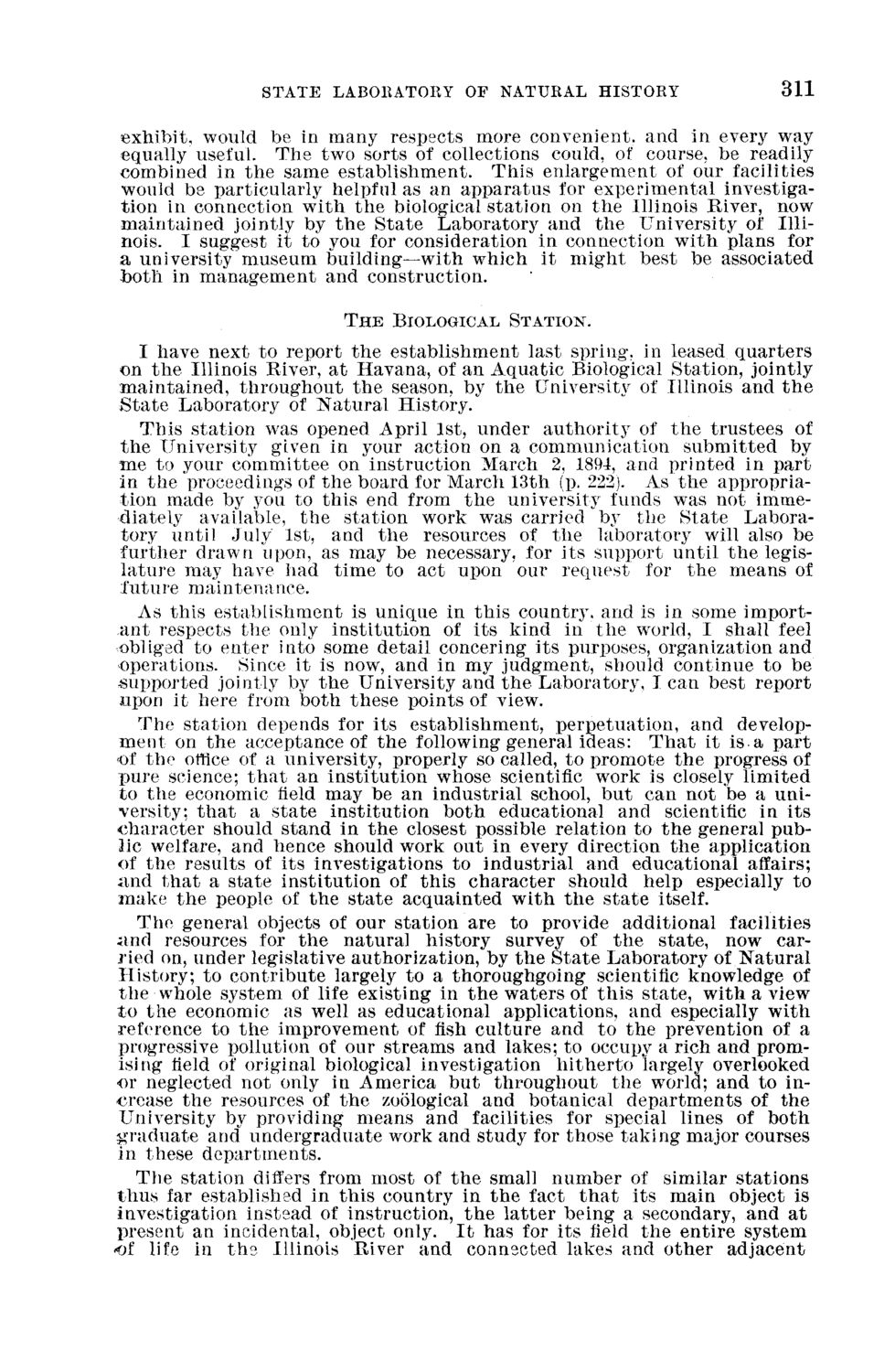| |
| |
Caption: Board of Trustees Minutes - 1894
This is a reduced-resolution page image for fast online browsing.

EXTRACTED TEXT FROM PAGE:
STATE LABORATORY OF NATURAL HISTORY 311 exhibit, would be in many respects more convenient, and in every way equally useful. The two sorts of collections could, of course, be readily combined in the same establishment. This enlargement of our facilities would be particularly helpful as an apparatus for experimental investigation in connection with the biological station on the Illinois River, now maintained jointly by the State Laboratory and the University of Illinois. I suggest it to you for consideration in connection with plans for a university museum building—with which it might best be associated both in management and construction. T H E BIOLOGICAL STATION. I have next to report the establishment last spring, in leased quarters on the Illinois River, at Havana, of an Aquatic Biological Station, jointly maintained, throughout the season, by the University of Illinois and t h e State Laboratory of Natural History. This station was opened April 1st, under authority of the trustees of the University given in your action on a communication submitted by me to your committee on instruction March 2, 1894, and printed in part in the proceedings of the board for March 13th (p. 222). As the appropriation made by you to this end from t h e university funds was not immediately available, the station work was carried by the State Laboratory until July 1st, and the resources of the laboratory will also be further drawn upon, as may be necessary, for its support until the legislature may have had time to act upon our request for the means of future maintenance. As this establishment is unique in this country, and is in some important respects the only institution of its kind in the world, I shall feel obliged to enter into some detail concering its purposes, organization and operations. Since it is now, and in my judgment, should continue to be supported jointly by the University and the Laboratory, l e a n best report upon it here from both these points of view. The station depends for its establishment, perpetuation, and development on the acceptance of the following general ideas: T h a t it is a part of the office of a university, properly so called, to promote the progress of pure science; t h a t an institution whose scientific work is closely limited to the economic field may be an industrial school, but can not be a university; t h a t a state institution both educational and scientific in its character should stand in the closest possible relation to the general public welfare, and hence should work out in every direction the application of the results of its investigations to industrial and educational affairs; and t h a t a state institution of this character should help especially to make the people of the state acquainted with the state itself. The general objects of our station are to provide additional facilities and resources for the natural history survey of the state, now carried on, under legislative authorization, by the State Laboratory of Natural History; to contribute largely to a thoroughgoing scientific knowledge of the whole system of life existing in the waters of this state, with a view t o the economic as well as educational applications, and especially with reference to the improvement of fish culture and to the prevention of a progressive pollution of our streams and lakes; to occupy a rich and promising field of original biological investigation hitherto largely overlooked or neglected not only in America but throughout the world; and to increase the resources of the zoological and botanical departments of the University by providing means and facilities for special lines of both graduate and undergraduate work and study for those taking major courses in these departments. The station differs from most of the small number of similar stations thus far established in this country in the fact t h a t its main object is investigation instead of instruction, t h e latter being a secondary, and at present an incidental, object only. I t has for its field the entire system of life in the Illinois River and connected lakes and other adjacent
| |